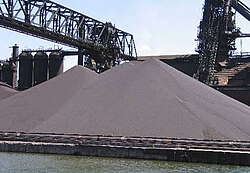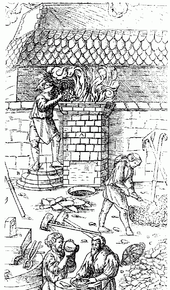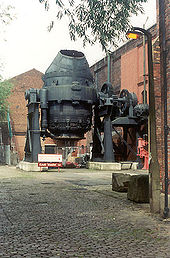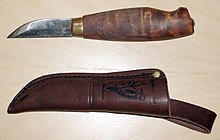Steel
| Steels |
|---|
 |
| Phases |
| Microstructures |
| Classes |
| Other iron-based materials |
Steel is an aloy consisting mostly of iron, with a carbon content between 0.2% and 2.1% by weight, depending on the grade. Carbon is the most cost-effective alloying material for iron, but various other alloying elements are used such as manganese, chromium, vanadium, and tungsten.[1] Carbon and other elements act as a hardening agent, preventing dislocations in the iron atom crystal lattice from sliding past one another. Varying the amount of alloying elements and form of their presence in the steel (solute elements, precipitated phase) controls qualities such as the hardness, ductility, and tensile strength of the resulting steel. Steel with increased carbon content can be made harder and stronger than iron, but is also less ductile.
Alloys with a higher carbon content are known as cast iron because of their lower melting point and castability.[1] Steel is also distinguished from wrought iron, which can contain a small amount of carbon, but it is included in the form of slag inclusions. Two distinguishing factors are steel's increased rust-resistance and better weldability. Steel can have varying amounts of caron in it to determine the strength. The strongest steel has 4% carbon in it. The rest is Iron.
Though steel had been produced by various inefficient methods long before the Renaissance, its use became more common after more efficient production methods were devised in the 17th century. With the invention of the Bessemer process in the mid-19th century, steel became a relatively inexpensive mass-produced material. Further refinements in the process, such as basic oxygen steelmaking, further lowered the cost of production while increasing the quality of the metal. Today, steel is one of the most common materials in the world and is a major component in buildings, infrastructure, tools, ships, automobiles, machines, and appliances. Modern steel is generally identified by various grades of steel defined by various standards organizations.

Material properties

Iron, like most metals, is found in the Earth's crust only in the form of an ore, ie. combined with other elements such as oxygen or sulfur.[2] Typical iron-containing minerals include Fe2O3—the form of iron oxide found as the mineral hematite, and FeS2—pyrite (fool's gold).[3] Iron is extracted from ore by removing oxygen and combining the ore with a preferred chemical partner such as carbon. This process, known as smelting, was first applied to metals with lower melting points, such as tin, which melts at approximately 250 °C (482 °F) and copper, which melts at approximately 1,000 °C (1,830 °F). In comparison, cast iron melts at approximately 1,370 °C (2,500 °F). All of these temperatures could be reached with ancient methods that have been used since the Bronze Age. Since the oxidation rate itself increases rapidly beyond 800 °C, it is important that smelting take place in a low-oxygen environment. Unlike copper and tin, liquid iron dissolves carbon quite readily. Smelting results in an alloy (pig iron) containing too much carbon to be called steel.[4] The excess carbon and other impurities are removed in a subsequent step.
Other materials are often added to the iron/carbon mixture to produce steel with desired properties. Nickel and manganese in steel add to its tensile strength and make austenite more chemically stable, chromium increases hardness and melting temperature, and vanadium also increases hardness while reducing the effects of metal fatigue. To prevent corrosion, at least 11% chromium is added to steel so that a hard oxide forms on the metal surface; this is known as stainless steel. Tungsten interferes with the formation of cementite, allowing martensite to form with slower quench rates, resulting in high speed steel. On the other hand, sulfur, nitrogen, and phosphorus make steel more brittle, so these commonly found elements must be removed from the ore during processing.[5]
The density of steel varies based on the alloying constituents, but usually ranges between 7.75 and 8.05 g/cm3 (0.280–0.291 lb/in3).[6]
Even in the narrow range of concentrations which make up steel, mixtures of carbon and iron can form a number of different structures, with very different properties. Understanding such properties is essential to making quality steel. At room temperature, the most stable form of iron is the body-centered cubic (BCC) structure α-ferrite. It is a fairly soft metallic material that can dissolve only a small concentration of carbon, no more than 0.021 wt% at 723 °C (1,333 °F), and only 0.005% at 0 °C (32 °F). If the steel contains more than 0.021% carbon then it transforms into a face-centered cubic (FCC) structure, called austenite or γ-iron. It is also soft and metallic but can dissolve considerably more carbon, as much as 2.1%[7] carbon at 1,148 °C (2,098 °F)), which reflects the upper carbon content of steel.[8]
When steels with less than 0.8% carbon, known as a hypoeutectoid steel, are cooled from an austenitic phase the mixture attempts to revert to the ferrite phase, resulting in an excess of carbon. One way for carbon to leave the austenite is for cementite to precipitate out of the mix, leaving behind iron that is pure enough to take the form of ferrite, resulting in a cementite-ferrite mixture. Cementite is a hard and brittle intermetallic compound with the chemical formula of Fe3C. At the eutectoid, 0.8% carbon, the cooled structure takes the form of pearlite, named after its resemblance to mother of pearl. For steels that have more than 0.8% carbon the cooled structure takes the form of pearlite and cementite.[9]
Perhaps the most important polymorphic form is martensite, a metastable phase which is significantly stronger than other steel phases. When the steel is in an austenitic phase and then quenched it forms into martensite, because the atoms "freeze" in place when the cell structure changes from FCC to BCC. Depending on the carbon content the martensitic phase takes different forms. Below approximately 0.2% carbon it takes an α ferrite BCC crystal form, but higher carbon contents take a body-centered tetragonal (BCT) structure. There is no thermal activation energy for the transformation from austenite to martensite. Moreover, there is no compositional change so the atoms generally retain their same neighbors.[10]
Martensite has a lower density than austenite does, so that transformation between them results in a change of volume. In this case, expansion occurs. Internal stresses from this expansion generally take the form of compression on the crystals of martensite and tension on the remaining ferrite, with a fair amount of shear on both constituents. If quenching is done improperly, the internal stresses can cause a part to shatter as it cools. At the very least, they cause internal work hardening and other microscopic imperfections. It is common for quench cracks to form when water quenched, although they may not always be visible.[11]
Heat treatment
There are many types of heat treating processes available to steel. The most common are annealing and quenching and tempering. Annealing is the process of heating the steel to a sufficiently high temperature to soften it. This process occurs through three phases: recovery, recrystallization, and grain growth. The temperature required to anneal steel depends on the type of annealing and the constituents of the alloy.[12]
Quenching and tempering first involves heating the steel to the austenite phase, then quenching it in water or oil. This rapid cooling results in a hard and brittle martensitic structure.[10] The steel is then tempered, which is just a specialized type of annealing. In this application the annealing (tempering) process transforms some of the martensite into cementite or spheroidite to reduce internal stresses and defects, which ultimately results in a more ductile and fracture-resistant metal.[13]
Steel production

When iron is smelted from its ore by commercial processes, it contains more carbon than is desirable. To become steel, it must be melted and reprocessed to reduce the carbon to the correct amount, at which point other elements can be added. This liquid is then continuously cast into long slabs or cast into ingots. 96% of steel is continuously cast, while only 4000 ingots are cast per year. The ingots are then heated in a soaking pit and hot rolled into slabs, blooms, or billets. Slabs are hot or cold rolled into sheet metal or plates. Billets are hot or cold rolled into bars, rods, and wire. Blooms are hot or cold rolled into structural steel, such as I-beams and rails. In modern foundries these processes often occur in one assembly line, with ore coming in and finished steel coming out.[14] Sometimes after a steel's final rolling it is heat treated for strength, however this is relatively rare.[15]
History of steelmaking

Ancient steel
Steel was known in antiquity, and may have been produced by managing the bloomery so that the bloom contained carbon.[16] Steel is mentioned in the Holy Bible: In Jeremiah 15:12 of the Authorized King James Version, it reads: "Shall iron break the northern iron and the steel?". However, it seems the Hebrews had no word for "steel" but used instead אסטמא (istoma) akin to the Greek word οτὀμωμα (otómoma) or hardening.[17] The earliest known production of steel is a piece of ironware excavated from an archaeological site in Anatolia and is about 4,000 years old.[18] Other ancient steel comes from East Africa, dating back to 1400 BC.[19] In the 4th century BC steel weapons like the Falcata were produced in the Iberian Peninsula, while Noric steel was used by the Roman military.[20] The Chinese of the Warring States (403–221 BC) had quench-hardened steel,[21] while Chinese of the Han Dynasty (202 BC – 220 AD) created steel by melting together wrought iron with cast iron, gaining an ultimate product of a carbon-intermediate—steel by the 1st century AD.[22][23]
Wootz steel and Damascus steel
Evidence of the earliest production of high carbon steel in the Indian Subcontinent was found in Samanalawewa area in Sri Lanka.[24] Wootz steel was produced in India by about 300 BC.[25] Along with their original methods of forging steel, the Chinese had also adopted the production methods of creating Wootz steel, an idea imported from India to China by the 5th century AD.[26] This early steel-making method in Sri Lanka employed the unique use of a wind furnace, blown by the monsoon winds and produced almost pure steel.[27] Also known as Damascus steel, wootz is famous for its durability and ability to hold an edge. It was originally created from a number of different materials including various trace elements. It was essentially a complicated alloy with iron as its main component. Recent studies have suggested that carbon nanotubes were included in its structure, which might explain some of its legendary qualities, though given the technology available at that time, they were produced by chance rather than by design.[28] Natural wind was used where the soil containing iron was heated up with the use of wood. The ancient Sinhalese managed to extract a ton of steel for every 2 tons of soil, a remarkable feat at the time. One such furnace was found in Samanalawewa and archaeologists were able to produce steel as the ancients did long ago.[27][29]
Crucible steel was produced in Merv by 9th to 10th century AD.[25] In the 11th century, there is evidence of the production of steel in Song China using two techniques: a "berganesque" method that produced inferior, inhomogeneous steel and a precursor to the modern Bessemer process that utilized partial decarbonization via repeated forging under a cold blast.[30]
Modern steelmaking

In Europe since 1600-s, the first step in producing steel has been the smelting iron ore into pig iron in a blast furnace from ore, charcoal, and air.[31] Modern methods use coke instead of charcoal, which has proven to be a great deal cheaper.[32][33][34]
Processes starting from bar iron
In these processes pig iron was fined in a finery forge to produce bar iron (wrought iron), which was then used in steel-making.[31]
The production of steel by the cementation process, was described in a treatise published in Prague in 1574 and was in use in Nuremberg from 1601. A similar process for case hardening armour and files was described in a book published in Naples in 1589. The process was introduced to England in about 1614.[35] It was produced by Sir Basil Brooke at Coalbrookdale during the 1610s. The raw material for this were bars of wrought iron. During the 17th century it was realised that the best steel came from oregrounds iron from a region of Sweden, north of Stockholm. This was still the usual raw material in the 19th century, almost as long as the process was used.[36][37]
Crucible steel is steel that has been melted in a crucible rather than being forged, with the result that it is more homogeneous. Most previous furnaces could not reach high enough temperatures to melt the steel. The early modern crucible steel industry resulted from the invention of Benjamin Huntsman in the 1740s. Blister steel (made as above) was melted in a crucible or in a furnace, and cast (usually) into ingots.[37][38]
Processes starting from pig iron


The modern era in steelmaking began with the introduction of Henry Bessemer's Bessemer process in 1858. His raw material was pig iron.[39] This enabled steel to be produced in large quantities cheaply, so that mild steel is now used for most purposes for which wrought iron was formerly used.[40] The Gilchrist-Thomas process (or basic Bessemer process) was an improvement to the Bessemer process, because it lined the converter with a basic material to remove phosphorus. Another improvement in steelmaking was the Siemens-Martin process, which complemented the Bessemer process.[37]
These were rendered obsolete by the Linz-Donawitz process of basic oxygen steelmaking, developed in the 1950s, and other oxygen steelmaking processes. Basic oxygen steelmaking is superior to previous steelmaking methods because the oxygen pumped into the furnace limits impurities.[41] Now, electric arc furnaces are a common method of reprocessing scrap metal to create new steel. They can also be used for converting pig iron to steel, but they use a great deal of electricity (about 440 kWh per metric ton), and are thus generally only economical when there is a plentiful supply of cheap electricity.[42]
Steel industry


It is common today to talk about "the iron and steel industry" as if it were a single entity, but historically they were separate products. The steel industry is often considered to be an indicator of economic progress, because of the critical role played by steel in infrastructural and overall economic development.[43]
The economic boom in China and India has caused a massive increase in the demand for steel in recent years. Between 2000 and 2005, world steel demand increased by 6%. Since 2000, several Indian [44] and Chinese steel firms have risen to prominence like Tata Steel (which bought Corus Group in 2007), Shanghai Baosteel Group Corporation and Shagang Group. ArcelorMittal is however the world's largest steel producer.
The British Geological Survey reports that in 2005, China was the top producer of steel with about one-third world share followed by Japan, Russia, and the USA.[45]
In 2008, steel started to be traded as a commodity in the London Metal Exchange. At the end of 2008, the steel industry faced a sharp downturn that led to many cut-backs.[46]
Recycling

Steel is one of the most recycled materials in the world,[47] and, as of 2007, more than 78% of steel was recycled in the United States.[48] In the United States it is the most widely recycled material; in 2000, more than 60 million metric tons were recycled.[47][49]
The most commonly recycled items are containers, automobiles, appliances, and construction materials. For example, in 2007, more than 97% of structural steel and 110% of automobiles were recycled, comparing the current steel consumption for each industry with the amount of recycled steel being produced.[48] A typical appliance is about 75% steel by weight[50] and automobiles are about 65% steel and iron.[51]
The steel industry has been actively recycling for more than 150 years, in large part because it is economically advantageous to do so. It is cheaper to recycle steel than to mine iron ore and manipulate it through the production process to form new steel. Steel does not lose any of its inherent physical properties during the recycling process, and has drastically reduced energy and material requirements compared with refinement from iron ore. The energy saved by recycling reduces the annual energy consumption of the industry by about 75%, which is enough to power eighteen million homes for one year.[52]

The BOS steelmaking uses between 25 and 35% recycled steel to make new steel. BOS steel usually has less residual elements in it, such as copper, nickel and molybdenum and is therefore more malleable than EAF steel so it is often used to make automotive fenders, soup cans, industrial drums or any product with a large degree of cold working. EAF steelmaking uses almost 100% recycled steel. This steel contains more residual elements that cannot be removed through the application of oxygen and lime so it is used to make structural beams, plates, reinforcing bar and other products that require little cold working.[53] Recycling one ton of steel saves 1,100 kilograms of iron ore, 630 kilograms of coal, and 55 kilograms of limestone.[54]
Because steel beams are manufactured to standardized dimensions, there is often very little waste produced during construction, and any waste that is produced may be recycled. For a typical 2,000-square-foot (200 m2) two-story house, a steel frame is equivalent to about six recycled cars, while a comparable wooden frame house may require as many as 40–50 trees.[55]
Contemporary steel
Modern steels are made with varying combinations of alloy metals to fulfill many purposes.[5] Carbon steel, composed simply of iron and carbon, accounts for 90% of steel production.[1] High strength low alloy steel has small additions (usually < 2% by weight) of other elements, typically 1.5% manganese, to provide additional strength for a modest price increase.[56] Low alloy steel is alloyed with other elements, usually molybdenum, manganese, chromium, or nickel, in amounts of up to 10% by weight to improve the hardenability of thick sections.[1] Stainless steels and surgical stainless steels contain a minimum of 11% chromium, often combined with nickel, to resist corrosion (rust). Some stainless steels are magnetic, while others are nonmagnetic.[57]
Some more modern steels include tool steels, which are alloyed with large amounts of tungsten and cobalt or other elements to maximize solution hardening. This also allows the use of precipitation hardening and improves the alloy's temperature resistance.[1] Tool steel is generally used in axes, drills, and other devices that need a sharp, long-lasting cutting edge. Other special-purpose alloys include weathering steels such as Cor-ten, which weather by acquiring a stable, rusted surface, and so can be used un-painted.[58]
Many other high-strength alloys exist, such as dual-phase steel, which is heat treated to contain both a ferritic and martensitic microstructure for extra strength.[59] Transformation Induced Plasticity (TRIP) steel involves special alloying and heat treatments to stabilize amounts of austentite at room temperature in normally austentite-free low-alloy ferritic steels. By applying strain to the metal, the austentite undergoes a phase transition to martensite without the addition of heat.[60] Maraging steel is alloyed with nickel and other elements, but unlike most steel contains almost no carbon at all. This creates a very strong but still malleable metal.[61] Twinning Induced Plasticity (TWIP) steel uses a specific type of strain to increase the effectiveness of work hardening on the alloy.[62] Eglin Steel uses a combination of over a dozen different elements in varying amounts to create a relatively low-cost metal for use in bunker buster weapons. Hadfield steel (after Sir Robert Hadfield) or manganese steel contains 12–14% manganese which when abraded forms an incredibly hard skin which resists wearing. Examples include tank tracks, bulldozer blade edges and cutting blades on the jaws of life.[63]
Most of the more commonly used steel alloys are categorized into various grades by standards organizations. For example, the Society of Automotive Engineers has a series of grades defining many types of steel.[64] The American Society for Testing and Materials has a separate set of standards, which define alloys such as A36 steel, the most commonly used structural steel in the United States.[65]
Though not an alloy, galvanized steel is a commonly used variety of steel which has been hot-dipped or electroplated in zinc for protection against rust.[66]
Uses

Iron and steel are used widely in the construction of roads, railways, infrastructure, and buildings. Most large modern structures, such as stadiums and skyscrapers, bridges, and airports, are supported by a steel skeleton. Even those with a concrete structure will employ steel for reinforcing. In addition to widespread use in major appliances and cars (Despite growth in usage of aluminium, it is still the main material for car bodies.), steel is used in a variety of other construction-related applications, such as bolts, nails, and screws.[67] Other common applications include shipbuilding, pipeline transport, mining, offshore construction, aerospace, white goods (e.g. washing machines), heavy equipment (e.g. bulldozers), office furniture, steel wool, tools, and armour in the form of personal vests or vehicle armour (better known as rolled homogeneous armour in this role).
Historically

Before the introduction of the Bessemer process and other modern production techniques, steel was expensive and was only used where no cheaper alternative existed, particularly for the cutting edge of knives, razors, swords, and other items where a hard, sharp edge was needed. It was also used for springs, including those used in clocks and watches.[37] With the advent of speedier and thriftier production methods, steel has been easier to obtain and much cheaper. It has replaced wrought iron for a multitude of purposes. However, the availability of plastics during the later 20th century allowed these materials to replace steel in many products due to their lower cost and weight.[68]
Long steel

- As supports in reinforced concrete
- Railroad tracks
- Structural steel in modern buildings and bridges
- Wires
Flat carbon steel
- Major appliances
- Magnetic cores
- The inside and outside body of automobiles, trains, and ships.
Stainless steel

- Cutlery
- Rulers
- Surgical equipment
- Wrist watches
See also
|
References
- ^ a b c d e Ashby, Michael F. (1992) [1986]. Engineering Materials 2 (with corrections ed.). Oxford: Pergamon Press. ISBN 0-08-032532-7.
{{cite book}}: Unknown parameter|coauthors=ignored (|author=suggested) (help) - ^ Winter, Mark. "Periodic Table: Iron". The University of Sheffield. Retrieved 2007-02-28.
- ^ F. Brookins, Theo (1899). "Common Minerals and Valuable Ores". Birds and All Nature. 6 (4). A. W. Mumford. Retrieved 2007-02-28.
{{cite journal}}: Unknown parameter|month=ignored (help) - ^ "Smelting". Britannica. Encyclopedia Britannica. 2007.
{{cite encyclopedia}}:|access-date=requires|url=(help) - ^ a b "Alloying of Steels". Metallurgical Consultants. 2006-06-28. Retrieved 2007-02-28.
- ^ Elert, Glenn. "Density of Steel". Retrieved 2009-04-23.
- ^ Sources differ on this value so it has been rounded to 2.1%, however the exact value is rather academic as plain-carbon steel is very rare made with this level of carbon. See:
- Smith & Hashemi 2006, p. 363—2.08%.
- Degarmo, Black & Kohser 2003, p. 75.—2.11%.
- Ashby & Jones 1992—2.14%.
- ^ Smith & Hashemi 2006, p. 363.
- ^ Smith & Hashemi 2006, p. 365–372.
- ^ a b Smith & Hashemi 2006, pp. 373–378.
- ^ "Quench hardening of steel". Retrieved 2009-07-19.
- ^ Smith & Hashemi 2006, p. 249.
- ^ Smith & Hashemi 2006, p. 388.
- ^ Smith & Hashemi 2006, pp. 361–362.
- ^ Bugayev et al. 2001, p. 225
- ^ Wagner, Donald B. "Early iron in China, Korea, and Japan". Retrieved 2007-02-28.
- ^ Beckmann, Johann (1846). A history of inventions, discoveries and origins. Vol. 2. H.G. Bohn. p. 324-325.
To the north of Judaea was situated Chalybia, the ancient country of steel.
- ^ "Ironware piece unearthed from Turkey found to be oldest steel". Retrieved 2009-03-27.
- ^ "Civilizations in Africa: The Iron Age South of the Sahara". Washington State University. Retrieved 2007-08-14.
- ^ "Noricus ensis," Horace, Odes, i. 16.9
- ^ Wagner, Donald B. (1993). Iron and Steel in Ancient China: Second Impression, With Corrections. Leiden: E.J. Brill. p. 243. ISBN 9004096329.
- ^ Needham, Joseph (1986). Science and Civilization in China: Volume 4, Part 3, Civil Engineering and Nautics. Taipei: Caves Books, Ltd. p. 563.
- ^ Gernet, 69.
- ^ Wilford, John Noble (1996-02-06). "Ancient Smelter Used Wind To Make High-Grade Steel". The New York Times.
- ^ a b Ann Feuerbach, 'An investigation of the varied technology found in swords, sabres and blades from the Russian Northern Caucasus' IAMS 25 for 2005, 27-43 at 29, apparently ultimately from the writings of Zosimos of Panopolis.
- ^ Needham, Volume 4, Part 1, 282.
- ^ a b G. Juleff (1996). "An ancient wind powered iron smelting technology in Sri Lanka". Nature. 379 (3): 60–63. doi:10.1038/379060a0.
- ^ Sanderson, Katharine (2006-11-15). "Sharpest cut from nanotube sword". News nature. Nature. doi:10.1038/news061113-11.
{{cite journal}}:|access-date=requires|url=(help) - ^ Wayman, M L and Juleff, G (1999). "Crucible Steelmaking in Sri Lanka". Historical Metallurgy. 33 (1): 26.
{{cite journal}}: CS1 maint: multiple names: authors list (link) - ^ Robert Hartwell (966). "Markets, Technology and the Structure of Enterprise in the Development of the Eleventh Century Chinese Iron and Steel Industry". Journal of Economic History. 26: 53–54.
- ^ a b R. F. Tylecote, A history of metallurgy 2 edn, Institute of Materials, London 1992, 95-99 and 102-105.
- ^ A. Raistrick, A Dynasty of Ironfounders (1953; York 1989)
- ^ C. K. Hyde, Technological Change and the British iron industry (Princeton 1977)
- ^ B. Trinder, The Industrial Revolution in Shropshire (Chichester 2000)
- ^ K. C. Barraclough, Steel before Bessemer: I Blister Steel: the birth of an industry (The Metals Society, London, 1984), 48-52.
- ^ P. W. King (2003). "The Cartel in Oregrounds Iron: trading in the raw material for steel during the eighteenth century". Journal of Industrial History. 6 (1): 25–49.
- ^ a b c d "Iron and steel industry". Britannica. Encyclopaedia Britannica. 2007.
{{cite encyclopedia}}:|access-date=requires|url=(help) - ^ K. C. Barraclough, Steel before Bessemer: II Crucible Steel: the growth of technology (The Metals Society, London, 1984).
- ^ James Moore Swank (1892). History of the Manufacture of Iron in All Ages. ISBN 0833734636.
- ^ "Bessemer process". Britannica. Vol. 2. Encyclopedia Britannica. 2005. p. 168.
{{cite encyclopedia}}:|access-date=requires|url=(help) - ^ "Basic oxygen process". Britannica. Encyclopedia Britannica. 2007.
{{cite encyclopedia}}:|access-date=requires|url=(help) - ^ J.A.T. Jones, B. Bowman, P.A. Lefrank, Electric Furnace Steelmaking, in The Making, Shaping and Treating of Steel, 525–660. R.J. Fruehan, Editor. 1998, The AISE Steel Foundation: Pittsburgh.
- ^ "Steel Industry". Retrieved 2009-07-12.
- ^ "India's steel industry steps onto world stage". Retrieved 2009-07-12.
- ^ "Long-term planning needed to meet steel demand". The News. 2008-03-01.
- ^ Uchitelle, Louis (2009-01-01). "Steel Industry, in Slump, Looks to Federal Stimulus". The New York Times. Retrieved 2009-07-19.
- ^ a b Hartman, Roy A. (2009). "Recycling". Encarta.
- ^ a b "Steel Recycling Rates at a Glance". Retrieved 2009-07-13.
- ^ "2005 Minerals Handbook" (PDF). February 2007. Retrieved 2008-06-15.
- ^ "Recycling steel appliances". Retrieved 2009-07-13.
- ^ "Steel: Driving auto recycling success". Retrieved 2009-07-13.
- ^ "Facts About Steel Recycling". Retrieved 2009-07-18.
- ^ "Steel". Retrieved 2009-07-13.
- ^ "Information on Recycling Steel Products". WasteCap of Massachusetts. Archived from the original on 2007-10-11. Retrieved 2007-02-28.
- ^ "Steel: the clear cut alternative for building homes" (PDF). Retrieved 2009-07-13.
- ^ "High strength low alloy steels". Schoolscience.co.uk. Retrieved 2007-08-14.
- ^ "Steel Glossary". American Iron and Steel Institute (AISI). Retrieved 2006-07-30.
- ^ "Steel Interchange". American Institute of Steel Construction Inc. (AISC). Archived from the original on 2007-12-22. Retrieved 2007-02-28.
- ^ "Dual-phase steel". Intota Expert Knowledge Services. Retrieved 2007-03-01.
- ^ Werner, Prof. Dr. mont. Ewald. "Transformation Induced Plasticity in low alloyed TRIP-steels and microstructure response to a complex stress history". Retrieved 2007-03-01.
- ^ "Properties of Maraging Steels". Retrieved 2009-07-19.
- ^ Mirko, Centi. "Transformation Induced Plasticity (TRIP), Twinning Induced Plasticity (TWIP) and Dual-Phase (DP) Steels". Tampere University of Technology. Archived from the original on 2008-03-07. Retrieved 2007-03-01.
{{cite web}}: Unknown parameter|coauthors=ignored (|author=suggested) (help) - ^ Hadfield manganese steel. Answers.com. McGraw-Hill Dictionary of Scientific and Technical Terms, McGraw-Hill Companies, Inc., 2003. Retrieved on 2007-02-28.
- ^ Bringas, John E. (2004). Handbook of Comparative World Steel Standards: Third Edition (PDF) (3rd. ed.). ASTM International. p. 14. ISBN 0-8031-3362-6. Archived from the original (PDF) on 2007-01-27.
- ^ Steel Construction Manual, 8th Edition, second revised edition, American Institute of Steel Construction, 1986, ch. 1 page 1-5
- ^ "Galvanic protection". Britannica. Encyclopedia Britannica. 2007.
{{cite encyclopedia}}:|access-date=requires|url=(help) - ^ Ochshorn, Jonathan (2002-06-11). "Steel in 20th Century Architecture". Encyclopedia of Twentieth Century Architecture. Retrieved 2007-02-28.
- ^ "Materials science". Britannica. Encyclopedia Britannica. 2007.
{{cite encyclopedia}}:|access-date=requires|url=(help)
Bibliography
- Bugayev, K.; Konovalov, Y.; Bychkov, Y.; Tretyakov, E.; Savin, Ivan V. (2001). Iron and Steel Production. The Minerva Group, Inc. ISBN 9780894991097. Retrieved 2009-07-19..
- Gernet, Jacques (1982). A History of Chinese Civilization. Cambridge: Cambridge University Press.
- Smith, William F.; Hashemi, Javad (2006). Foundations of Materials Science and Engineering (4th ed.). McGraw-Hill. ISBN 0-07-295358-6.
Further reading
- Duncan Burn; The Economic History of Steelmaking, 1867–1939: A Study in Competition. Cambridge University Press, 1961.
- Harukiyu Hasegawa, The Steel Industry in Japan: A Comparison with Britain. 1996.
- J. C. Carr and W. Taplin, History of the British Steel Industry. Harvard University Press, 1962.
- H. Lee Scamehorn, Mill & Mine: The Cf&I in the Twentieth Century. University of Nebraska Press, 1992.
- Needham, Joseph (1986). Science and Civilization in China: Volume 4, Part 1 & Part 3. Taipei: Caves Books, Ltd.
- Warren, Kenneth, Big Steel: The First Century of the United States Steel Corporation, 1901–2001. University of Pittsburgh Press, 2001.
